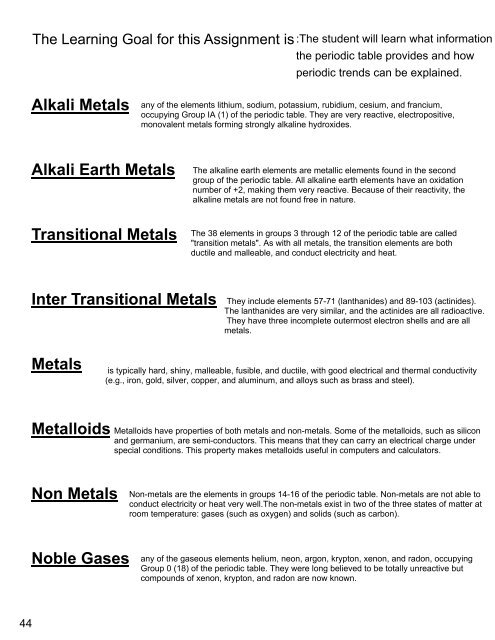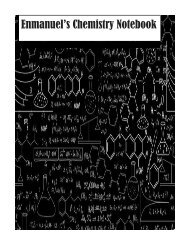You also want an ePaper? Increase the reach of your titles
YUMPU automatically turns print PDFs into web optimized ePapers that Google loves.
The Learning Goal for this Assignment is<br />
Alkali Metals<br />
any of the elements lithium, sodium, potassium, rubidium, cesium, and francium,<br />
occupying Group IA (1) of the periodic table. They are very reactive, electropositive,<br />
monovalent metals forming strongly alkaline hydroxides.<br />
Alkali Earth Metals<br />
Transitional Metals<br />
The alkaline earth elements are metallic elements found in the second<br />
group of the periodic table. All alkaline earth elements have an oxidation<br />
number of +2, making them very reactive. Because of their reactivity, the<br />
alkaline metals are not found free in nature.<br />
The 38 elements in groups 3 through 12 of the periodic table are called<br />
"transition metals". As with all metals, the transition elements are both<br />
ductile and malleable, and conduct electricity and heat.<br />
Inter Transitional Metals<br />
They include elements 57-71 (lanthanides) and 89-103 (actinides).<br />
The lanthanides are very similar, and the actinides are all radioactive.<br />
They have three incomplete outermost electron shells and are all<br />
metals.<br />
Metals<br />
is typically hard, shiny, malleable, fusible, and ductile, with good electrical and thermal conductivity<br />
(e.g., iron, gold, silver, copper, and aluminum, and alloys such as brass and steel).<br />
Metalloids<br />
Metalloids have properties of both metals and non-metals. Some of the metalloids, such as silicon<br />
and germanium, are semi-conductors. This means that they can carry an electrical charge under<br />
special conditions. This property makes metalloids useful in computers and calculators.<br />
Non Metals<br />
Non-metals are the elements in groups 14-16 of the periodic table. Non-metals are not able to<br />
conduct electricity or heat very well.The non-metals exist in two of the three states of matter at<br />
room temperature: gases (such as oxygen) and solids (such as carbon).<br />
Noble Gases<br />
any of the gaseous elements helium, neon, argon, krypton, xenon, and radon, occupying<br />
Group 0 (18) of the periodic table. They were long believed to be totally unreactive but<br />
compounds of xenon, krypton, and radon are now known.




